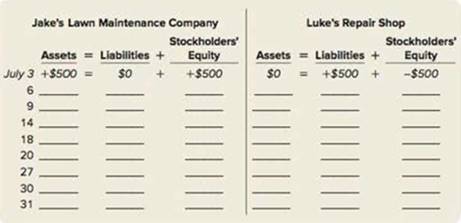
Financial Accounting
3rd Edition
ISBN: 9780078025549
Author: J. David Spiceland, Wayne M Thomas, Don Herrmann
Publisher: McGraw-Hill Education
expand_more
expand_more
format_list_bulleted
Concept explainers
Textbook Question
Chapter 2, Problem 2.5AP
Refer to the transactions described in P2–4A. Keep in mind that Jake may not need to record all transactions.
Analyze the impact of transactions on the
Flip Side of P2–4A

Required:
1. Record each transaction for Luke’s Repair Shop. Keep in mind that Luke may not need to record all transactions.
2. Using the format shown above, indicate the impact of each transaction on the accounting equation for each company.
Expert Solution & Answer
Want to see the full answer?
Check out a sample textbook solution
Students have asked these similar questions
Goodwill is an example of an indefinite-life intangible asset, meaning that public companies must test it for impairment rather than regularly amortizing to systematically reduce its value on the balance sheet of the public company.
Can anyone recap the difference between limited-life versus indefinite-life intangible assets? Any specific examples of either category?
Why are adjusting journal entries necessary at the end of an accounting period? Need he
Why are adjusting journal entries necessary at the end of an accounting period?i need help
Chapter 2 Solutions
Financial Accounting
Ch. 2 - Prob. 1RQCh. 2 - 2.List the steps we use to measure external...Ch. 2 - 3.Each external transaction will have a dual...Ch. 2 - 4.Describe the impact of each of these external...Ch. 2 - Prob. 5RQCh. 2 - Prob. 6RQCh. 2 - Prob. 7RQCh. 2 - Prob. 8RQCh. 2 - Prob. 9RQCh. 2 - 10.Suzanne knows that an increase to an expense...
Ch. 2 - 11.What is a journal? What is a journal entry?Ch. 2 - Prob. 12RQCh. 2 - Prob. 13RQCh. 2 - Prob. 14RQCh. 2 - 15.Describe the events that correspond to the...Ch. 2 - 16.What does a T-account represent? What is the...Ch. 2 - Prob. 17RQCh. 2 - Prob. 18RQCh. 2 - Prob. 19RQCh. 2 - 20.If total debits equal total credits in the...Ch. 2 - List steps in the measurement process (LO21) Below...Ch. 2 - Balance the accounting equation (LO22) Using the...Ch. 2 - Suppose a local company has the following balance...Ch. 2 - Analyze the Impact of transactions on the...Ch. 2 - Understand the effect of debits and credits on...Ch. 2 - Prob. 2.6BECh. 2 - Record transactions (LO24) The following...Ch. 2 - Prob. 2.8BECh. 2 - Analyze T-accounts (LO25) Consider the following...Ch. 2 - Prob. 2.10BECh. 2 - Prob. 2.11BECh. 2 - Correct a trial balance (LO26) Your study partner...Ch. 2 - Listed below are several terms and phrases...Ch. 2 - Prob. 2.2ECh. 2 - Analyze the Impact of transactions on the...Ch. 2 - Analyze the Impact of transactions on the...Ch. 2 - Understand the components of retained earnings...Ch. 2 - Indicate the debit or credit balance of accounts...Ch. 2 - Associate debits and credits with external...Ch. 2 - Prob. 2.8ECh. 2 - Identify transactions (LO24) Below are recorded...Ch. 2 - Prob. 2.10ECh. 2 - Record transactions (LO24) Bearcat Construction...Ch. 2 - Correct recorded transactions (LO24) Below are...Ch. 2 - Correct recorded transactions (LO24) Below are...Ch. 2 - Prob. 2.14ECh. 2 - Post transactions to T-accounts (LO25) Consider...Ch. 2 - Identify transaction (LO25) Below are T-accounts....Ch. 2 - Prob. 2.17ECh. 2 - Prepare o trial balance (LO26) Below is the...Ch. 2 - Prob. 2.19ECh. 2 - Prob. 2.20ECh. 2 - Below is a list of activities for Jayhawk...Ch. 2 - Prob. 2.2APCh. 2 - Prob. 2.3APCh. 2 - Prob. 2.4APCh. 2 - Refer to the transactions described in P24A. Keep...Ch. 2 - Prob. 2.6APCh. 2 - Prob. 2.7APCh. 2 - Prob. 2.8APCh. 2 - Prob. 2.9APCh. 2 - Analyze the impact of transactions on the...Ch. 2 - Prob. 2.2BPCh. 2 - Prob. 2.3BPCh. 2 - Record transactions (LO24) Flip Side of P25B Eli...Ch. 2 - Prob. 2.5BPCh. 2 - Prob. 2.6BPCh. 2 - Prob. 2.7BPCh. 2 - Prob. 2.8BPCh. 2 - Prob. 2.9BPCh. 2 - Prob. 2.1APCPCh. 2 - Prob. 2.2APFACh. 2 - Prob. 2.3APFACh. 2 - Prob. 2.4APCACh. 2 - Prob. 2.5APECh. 2 - Prob. 2.6APIRCh. 2 - Prob. 2.7APWC
Knowledge Booster
Learn more about
Need a deep-dive on the concept behind this application? Look no further. Learn more about this topic, accounting and related others by exploring similar questions and additional content below.Similar questions
arrow_back_ios
SEE MORE QUESTIONS
arrow_forward_ios
Recommended textbooks for you

 AccountingAccountingISBN:9781337272094Author:WARREN, Carl S., Reeve, James M., Duchac, Jonathan E.Publisher:Cengage Learning,
AccountingAccountingISBN:9781337272094Author:WARREN, Carl S., Reeve, James M., Duchac, Jonathan E.Publisher:Cengage Learning, Accounting Information SystemsAccountingISBN:9781337619202Author:Hall, James A.Publisher:Cengage Learning,
Accounting Information SystemsAccountingISBN:9781337619202Author:Hall, James A.Publisher:Cengage Learning, Horngren's Cost Accounting: A Managerial Emphasis...AccountingISBN:9780134475585Author:Srikant M. Datar, Madhav V. RajanPublisher:PEARSON
Horngren's Cost Accounting: A Managerial Emphasis...AccountingISBN:9780134475585Author:Srikant M. Datar, Madhav V. RajanPublisher:PEARSON Intermediate AccountingAccountingISBN:9781259722660Author:J. David Spiceland, Mark W. Nelson, Wayne M ThomasPublisher:McGraw-Hill Education
Intermediate AccountingAccountingISBN:9781259722660Author:J. David Spiceland, Mark W. Nelson, Wayne M ThomasPublisher:McGraw-Hill Education Financial and Managerial AccountingAccountingISBN:9781259726705Author:John J Wild, Ken W. Shaw, Barbara Chiappetta Fundamental Accounting PrinciplesPublisher:McGraw-Hill Education
Financial and Managerial AccountingAccountingISBN:9781259726705Author:John J Wild, Ken W. Shaw, Barbara Chiappetta Fundamental Accounting PrinciplesPublisher:McGraw-Hill Education


Accounting
Accounting
ISBN:9781337272094
Author:WARREN, Carl S., Reeve, James M., Duchac, Jonathan E.
Publisher:Cengage Learning,

Accounting Information Systems
Accounting
ISBN:9781337619202
Author:Hall, James A.
Publisher:Cengage Learning,

Horngren's Cost Accounting: A Managerial Emphasis...
Accounting
ISBN:9780134475585
Author:Srikant M. Datar, Madhav V. Rajan
Publisher:PEARSON

Intermediate Accounting
Accounting
ISBN:9781259722660
Author:J. David Spiceland, Mark W. Nelson, Wayne M Thomas
Publisher:McGraw-Hill Education

Financial and Managerial Accounting
Accounting
ISBN:9781259726705
Author:John J Wild, Ken W. Shaw, Barbara Chiappetta Fundamental Accounting Principles
Publisher:McGraw-Hill Education
The ACCOUNTING EQUATION For BEGINNERS; Author: Accounting Stuff;https://www.youtube.com/watch?v=56xscQ4viWE;License: Standard Youtube License